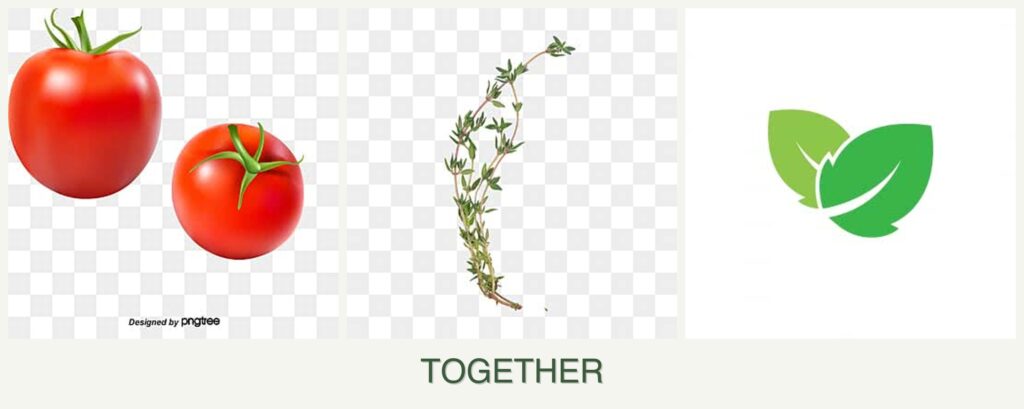
Can you plant tomatoes, thyme and mint together?
Can You Plant Tomatoes, Thyme, and Mint Together?
Gardening enthusiasts often explore companion planting to enhance their garden’s productivity and health. When considering planting tomatoes, thyme, and mint together, it’s essential to understand their compatibility and how they interact with each other. In this article, you’ll learn whether these plants can be grown together successfully, the benefits and challenges of doing so, and practical tips for optimal growth.
Compatibility Analysis
The short answer is: Yes, you can plant tomatoes, thyme, and mint together, but with some considerations. These plants can coexist harmoniously if their specific needs are addressed. Here’s why:
- Growth Requirements: Tomatoes thrive in full sun, while thyme prefers similar conditions. Mint can tolerate partial shade, making it adaptable to different spots in your garden.
- Pest Control: Thyme and mint are known for their pest-repellent properties. Thyme can deter worms and moths, while mint helps keep ants and aphids away, benefiting the tomatoes.
- Nutrient Needs: Tomatoes are heavy feeders, requiring nutrient-rich soil, while thyme and mint have moderate nutrient needs. Ensuring soil fertility can help all plants thrive.
- Spacing: Proper spacing is crucial. Mint spreads aggressively, so it should be contained, perhaps in a pot, to prevent it from overtaking other plants.
Growing Requirements Comparison Table
| Plant | Sunlight Needs | Water Requirements | Soil pH & Type | Hardiness Zones | Spacing Requirements | Growth Habit |
|---|---|---|---|---|---|---|
| Tomato | Full sun | Regular, deep | 6.0-6.8, loamy | 3-10 | 18-24 inches | 3-10 feet tall |
| Thyme | Full sun | Low, well-drained | 6.0-8.0, sandy | 5-9 | 12-18 inches | 6-12 inches tall |
| Mint | Partial shade | Moderate, moist | 6.0-7.5, rich | 3-11 | 12-24 inches | 12-18 inches tall |
Benefits of Planting Together
- Pest Repellent Properties: Thyme and mint naturally deter pests that commonly affect tomatoes, reducing the need for chemical pesticides.
- Improved Flavor: Some gardeners believe that thyme can enhance the flavor of tomatoes when grown nearby.
- Space Efficiency: Utilizing vertical space with tomato cages or trellises allows thyme and mint to spread below.
- Soil Health: Mint’s root system can help prevent soil erosion, maintaining soil health for all plants.
- Pollinator Attraction: Thyme flowers attract bees, aiding in the pollination of tomatoes.
Potential Challenges
- Competition for Resources: Mint’s vigorous growth can overshadow other plants, so containment is necessary.
- Different Watering Needs: Tomatoes require consistent watering, whereas thyme prefers drier conditions.
- Disease Susceptibility: Overcrowding can increase humidity and disease risk, so proper spacing is vital.
- Harvesting Considerations: Mint’s rapid growth may complicate access to tomatoes, so strategic planting is essential.
Planting Tips & Best Practices
- Optimal Spacing: Ensure 18-24 inches between tomato plants and 12-18 inches for thyme. Mint should be planted separately or in containers.
- Timing: Plant tomatoes after the last frost, thyme in spring, and mint any time during the growing season.
- Container vs. Garden Bed: Consider planting mint in containers to control its spread.
- Soil Preparation: Amend soil with compost to support tomatoes and thyme, ensuring good drainage for thyme.
- Companion Plants: Basil and marigolds can also be planted with tomatoes and thyme for additional pest control and aesthetic appeal.
FAQ Section
Can you plant tomatoes and mint in the same pot?
It’s best to plant mint in a separate pot due to its invasive growth habit.
How far apart should tomatoes and thyme be planted?
Space tomatoes 18-24 inches apart and thyme 12-18 inches apart for optimal growth.
Do tomatoes and mint need the same amount of water?
No, tomatoes need regular, deep watering, while mint prefers moderate moisture.
What should not be planted with tomatoes, thyme, and mint?
Avoid planting tomatoes with fennel or dill, which can inhibit their growth.
Will thyme affect the taste of tomatoes?
Thyme can subtly enhance the flavor of nearby tomatoes without overpowering it.
When is the best time to plant these together?
Plant tomatoes and thyme in spring after the last frost, and mint at any time during the growing season.
By understanding these plants’ needs and how they interact, you can successfully incorporate tomatoes, thyme, and mint into your garden, reaping the benefits of companion planting.



Leave a Reply